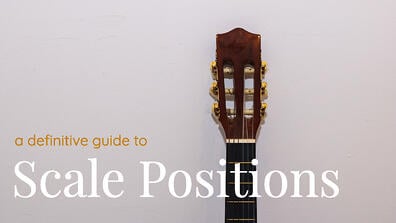
How to Solo on II-V-I
Dec 13, 2020The Most Common Progression in Jazz
Hello again! I'm so glad you could join us again. If you're reading this, it might be because you are interested in learning how to solo on II-V-I progressions. Seeing as how this is, in fact, the most common progression in jazz, it's probably a good place to start!
Download ALL of the licks here: "How to Solo on II-V-I" PDF (includes TAB)
Join our Community here.
In this lesson, in addition to discussing the progression itself, I will be discussing the three most common chord types in jazz music. They are major 7th, minor 7th, and dominant 7th. It just so happens that these also make up the three chords in a standard II-V-I progression.
The Basic Progression
If we are in the key of C major, the II chord will be Dm7, the V chord will be G7, and the I chord will be Cmaj7. My recommendation is that you learn these three parts for each chord quality: chords, scales/modes, and arpeggios.
When you think of it that way, it's not so bad, huh?
The great thing about this is that if you are able to master these three chord/scale qualities, you'll have actually done a lot of fretboard and theoretical work in the process!
With that said, let's go ahead and get started.
It's All C Major
Is it really that simple? Well, in essence, yes.
But if you want to sound like a real jazzer, keep reading. All three chords fall into one key and you can technically just play that one scale, but you wouldn't really be hitting all the changes and it wouldn't sound very "jazz."
II-V-I Chord Shapes
For this lesson, we will start with chord shapes. 80-90% of the time you spend in a band setting will be spend comping behind another soloist or melody player. Therefore, it is important to be able to accompany them effectively. Learning your chord shapes also helps to increase your knowledge of the fretboard.
In an effort to not overwhelm you, we'll give you three different shapes for each chord in different positions on the neck.
Here are a few shapes for Dm7.

Next, we have a few more for G7.

And lastly, some shapes for Cmaj7.
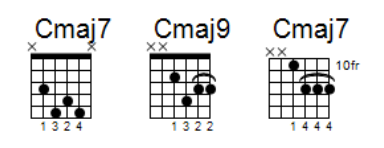
In addition to knowing these shapes, it is important to make sure you can voice-lead these correctly.
For that reason, here are all of the shapes we've provided in nicely voice-led progressions.
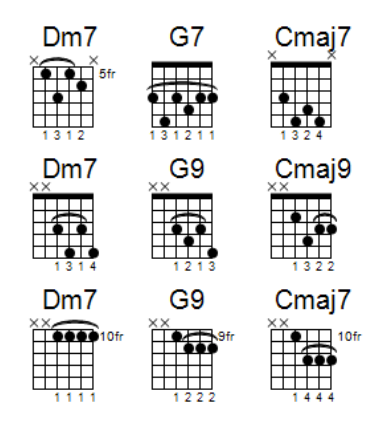
Why are some of these missing the root?
Glad you asked! Ok, maybe you didn't, but I'm going to tell you.
As guitar players, we only have so many notes we can access at a time. For that reason, there are certain notes that we can omit and still get the sound of the chord. The first of these is the 5th. Second, since we are playing with bass players most of the time, we can omit the root.
That's how we get some of these more colorful extended voicings using 9ths.
II-V-I Arpeggios
Next, let's get into some arpeggio shapes. As you may already know, it's important to be able to play through these changes with more than just up-and-down scale patterns. For that reason, incorporating some arpeggio shapes is crucial!
Here are some basic arpeggio shapes for Dm7 in different in positions.
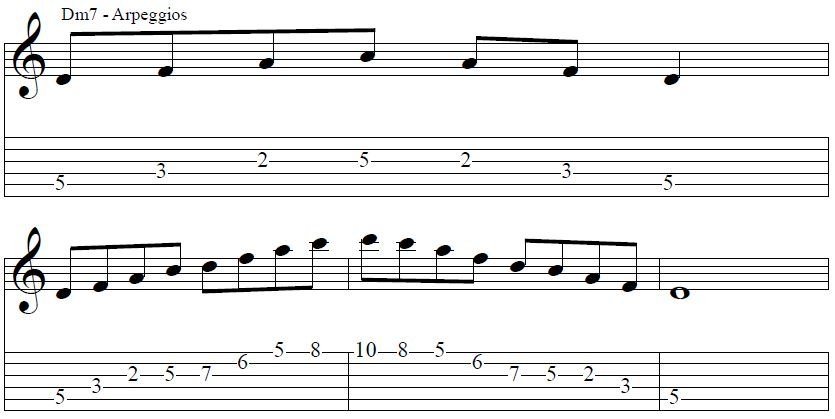
One of the major benefits of learning these things all over the neck like this is that you begin to map out the fretboard for yourself.
Next, we have some more shapes for G7.

Dominant shapes are deceptively tricky, so make sure you spend some time with this to really get them under your belt.
And last but not least, we have some shapes over Cmaj7.

The great thing about Cmaj7 is that you can place Am7 or Em7 material against it and vice versa as they are diatonically related. See our lesson on chord substitutions for some guidelines on how to approach this concept.
II-V-I Scales
And for the last bit of "nuts and bolts" on the topic, we'll go over scales and modes that can fit each chord. The reason I've saved this for last is because scales are often treated as a "solution" to improvisation, but they're really just vocabulary. You can't play scales up and down and say you're really making melodies. That's why it's important to transcribe and, more importantly, to listen.
Anyway, enough of that. Here are some scale shapes that will fit over each of these three chords!
Let's start with Dm7.

Next, of course, is G7.

And lastly, we have Cmaj7.

You can also try raising the F (4th note) to F# for a Lydian sound.
Guide Tone Lines
Now we're going to combine these arpeggios and scales to formulate some neat phrases where we target the guide tones on strong beats. Guide tones are the 3rds and 7ths of the chord, and if you are serious about your jazz playing, you'll learn how to hit these and when. This is extremely important!
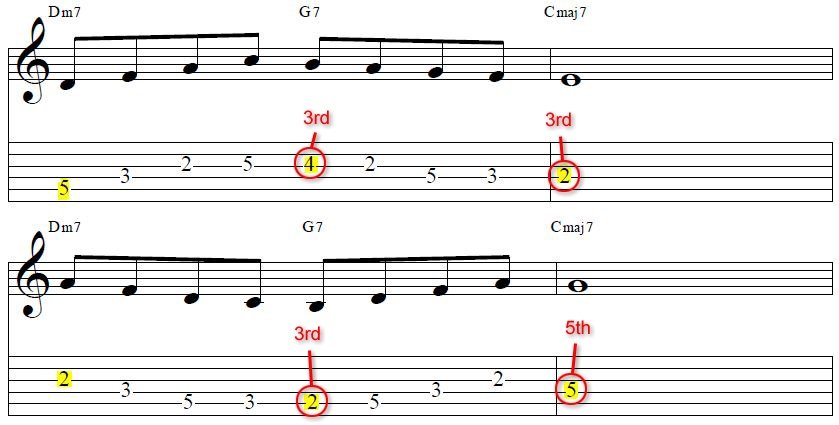
Pay attention to where the chord tones are landing within the line.
Are you noticing a common theme here? We are making it a point to place them on strong beats. This is really the "secret sauce" in making the chords stand out.
Eventually, the idea is to get so good at this that you can make the progressions heard without any bass or chordal accompaniment.
Download ALL of the licks here: "How to Solo on II-V-I" PDF (includes TAB)
The changes should be heard on their own through your improvisation. I know some guys like the "outside" playing, and that's great, but to really do that effectively, you have to know how to do the "inside" playing first!
Repurposing This Information
As with anything you learn in your jazz guitar studies, it's important to be able to take what you learn and find new ways to use or apply it.
And since we've got a plethora of articles on different II-V topics, I thought it would be a good idea to list a couple of them here for your reference.
How to Improvise on Minor II-V - You can take some of the information here and alter just a few notes to make it fit over minor II-V progressions.
For example, if you have Dm7 - G7 - Cmaj7, you can change it to Dm7b5, G7b9, and Cm6 or Cm(maj7) with a few simple modifications.
Dm7b5 = You'll just have to flat the 5th, so the notes are D F Ab C
G7b9 = You can take any 9ths (A) and lower them to Ab
Cm6 = C Eb G A
Cm(maj7) = C Eb G B
Make Your Hip Jazz Guitar Lick Even Hipper - Here, we'll talk about retargeting your II-V-I licks to get some really interesting sounds out of them.
Jump In
Now it's your turn to try! Take some of these concepts and apply them to tunes right away. I always recommend starting with a tune like Stella by Starlight since it has several II-V progressions.
Lastly, remember to subscribe to our YouTube channel for more helpful tips and lessons. Share this with your friends and help us spread the word!
Please comment below with your questions and comments. Feel free to share your ideas with us about playing faster. See you soon!
**Note from the editor**This post was updated 12/15/2020. Layout, feature image and syntax.

